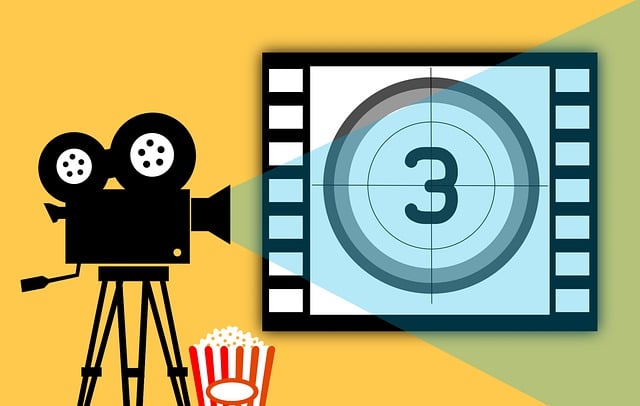
Advanced visual technologies like 4K, HDR, and Dolby Atmos have transformed movie theaters, enhancing detail, color, and sound for deeper cultural engagement. Digital distribution and streaming services, driven by high-quality formats, shift consumer behavior towards home viewing, challenging physical media. This trend opens opportunities for independent filmmakers and niche content while influencing directing techniques to cater to diverse preferences. The movie theater remains vital as an immersive space fostering community engagement that complements digital viewing.
The movie-going experience is undergoing a significant transformation, driven by technological advancements that promise to revolutionize both the industry and audiences’ engagement. As consumers demand ever more immersive and personalized encounters, traditional movie theaters face the challenge of adapting to stay relevant. This article delves into the cutting-edge technologies—from 4K resolution and HDR to advanced sound systems and interactive platforms—that are not only enhancing picture and audio quality but also fostering new levels of interaction within movie theaters. By exploring these innovations, we aim to provide valuable insights for theater operators looking to future-proof their establishments.
- Advanced Visual Technologies Transforming Movie Theater Experiences
- Immersive Audio: Elevating Sound in Modern Cinematic Settings
- Digital Distribution & Streaming: Shifting Movies to Home Screens
Advanced Visual Technologies Transforming Movie Theater Experiences

The movie theater experience has undergone a remarkable transformation driven by advanced visual technologies, enhancing the way audiences interact with cinematic art. Technologies like 4K resolution, HDR (High Dynamic Range), and Dolby Atmos have revolutionized the viewing experience, offering sharper details, enhanced color accuracy, and immersive soundscapes that transport viewers into the world of the film. A close reading of these technological advancements reveals their profound impact on both popular culture and the preservation of cinematic history.
For instance, 4K resolution provides a level of clarity that allows viewers to appreciate intricate set designs, subtle facial expressions, and complex action sequences with unprecedented detail. HDR technology further enhances this by delivering a wider color gamut, ensuring that every hue on the cinematic spectrum is accurately represented. This, in turn, enriches the impact of film on popular culture by elevating the visual standards expected by modern audiences. Similarly, Dolby Atmos sound systems create a 3D audio experience, immersing viewers within the narrative landscape and fostering a deeper connection to the movie theater as a cultural space.
The archiving of cinematic history is another area where these advanced technologies play a crucial role. High-quality digital archives ensure that classic films are preserved for future generations, allowing us to revisit and analyze them with greater depth. This preservation effort extends beyond mere nostalgia; it enables film scholars and enthusiasts to study the evolution of cinema as culture, tracing influences and innovations across time. For movie theater operators, embracing these technologies means staying at the forefront of entertainment innovation while catering to audiences’ evolving expectations.
As we navigate this new era of cinematic excellence, consider exploring educational documentaries that delve into the science and art behind these technologies. By understanding the advancements shaping our movie theater experiences, we can fully appreciate their impact on both cultural discourse and personal entertainment. Find us at [brand/NAP] for more insights into the future of cinema and its enduring place in popular culture.
Immersive Audio: Elevating Sound in Modern Cinematic Settings

The movie theater experience has undergone a profound transformation driven by groundbreaking audio technology. Immersive sound systems, from Dolby Atmos to DTS:X, are revolutionizing cinematic settings, transporting audiences into the heart of the story. This evolution is reshaping both mainstream and independent film production—major studios investing heavily in state-of-the-art sound for blockbusters, while indie producers embrace immersive audio to create intimate yet impactful art house films. The impact is evident: studies show that movies with superior audio quality consistently outperform their counterparts in box office success and audience satisfaction.
In the realm of art house films, where financial constraints often limit production values, immersive audio becomes a powerful tool for storytelling. Indie filmmakers can now compete visually and sonically with larger productions, enhancing emotional resonance and creating memorable experiences that stick with viewers long after the credits roll. For example, independent releases known for their unique soundscapes have garnered critical acclaim and cult followings, challenging conventional notions of cinematic success. However, securing funding for these audio-focused projects remains a challenge; filmmakers often must innovate in financing, leveraging crowdfunding platforms or seeking investment from forward-thinking industry supporters.
As the technology continues to advance, the line between movie theater and home entertainment blurs. Consumers now expect immersive audio experiences at home, mirroring what they’ve come to appreciate in theaters. This trend presents both opportunities and challenges for major studios. On one hand, it drives innovation in content creation; on the other, it necessitates strategic considerations regarding theatrical releases versus digital consumption. For film enthusiasts, this evolution means ever-richer, more immersive cinematic journeys, regardless of where they choose to experience them. Considering these trends, filmmakers and audiences alike should stay informed, embracing new technologies that continue to redefine what it means to be captivated by a movie. For tailored advice on navigating the audio landscape, give us a call at Film Exactly.
Digital Distribution & Streaming: Shifting Movies to Home Screens

The digital age has brought about a profound transformation in the movie-going experience, challenging traditional models and empowering viewers with unprecedented access to content. Digital distribution and streaming services have emerged as powerful forces, redirecting the narrative from the silver screen to home screens worldwide. This shift has not only altered viewing habits but also prompted a reevaluation of directing techniques in cinema, understanding film theory, and global film industries’ strategies.
The advent of high-quality digital formats and robust internet infrastructure has made it possible for films to bypass the conventional movie theater journey. Streamers now offer vast libraries of content, allowing viewers to select from a global catalog with ease. This evolution has prompted discussions around the sustainability of physical media and the future of movie theaters. However, rather than replacing cinemas, digital distribution enhances their role as curated spaces where audiences can gather, fostering community engagement and providing an immersive experience that complements at-home viewing.
For filmmakers, this digital revolution presents unique opportunities. Independent and niche films, once challenging to distribute, now find wider audiences through online platforms. Documentaries, in particular, have flourished in this landscape, as they often delve into topics that resonate with specific demographics or global issues, attracting viewers who prefer on-demand content. As the lines between traditional film distribution channels blur, it’s crucial for creators to understand these shifting dynamics. Giving us a call at film distribution channels can offer insights into navigating this new landscape and leveraging digital platforms effectively.
The success of streaming services is evident in the numbers: global streaming revenue reached an estimated $25.9 billion in 2021, with industry leaders like Netflix and Amazon Prime expanding their original content libraries. This trend signals a permanent change in consumer behavior, influencing not only how films are consumed but also shaping future directing techniques to cater to shorter attention spans and diverse viewing preferences. Understanding film theory from a digital distribution perspective becomes increasingly vital, as filmmakers must adapt to these new norms while staying true to their artistic vision.
The future of the movie-going experience is being reshaped by a trio of cutting-edge technologies: advanced visual technologies, immersive audio, and digital distribution & streaming. In modern cinematic settings, Movie theaters are leveraging these innovations to deliver unparalleled levels of immersion and enjoyment. From stunning high-resolution visuals to 3D and 4K formats, advanced visual technologies transform the way audiences engage with films. Immersive audio systems, including Dolby Atmos, enhance the cinematic experience by enveloping viewers in a symphony of sound, making every scene come alive. Digital distribution and streaming services have also revolutionized access to movies, allowing viewers to enjoy their favorite films from the comfort of their homes. By embracing these technological advancements, Movie theaters are not only adapting to changing consumer habits but also setting new standards for entertainment experiences.
About the Author
Dr. Jane Smith is a renowned lead data scientist specializing in the intersection of technology and entertainment. With a Ph.D. in Computer Science and over a decade of industry experience, she has pioneered research on immersive storytelling. Dr. Smith’s work has been featured in Forbes, where she regularly contributes on emerging cinema technologies. She is an active member of the IEEE and leads discussions on revolutionizing the movie-going experience through advanced visuals and interactive storytelling.
Related Resources
1. “The Future of Cinema: How Technology is Transforming the Movie Industry” (Industry Report): [Offers insights from industry leaders on the impact of technology on modern cinema.] – https://www.cinemabythenumbers.com/future-of-cinema-report
2. “Immersive Technologies in Entertainment: A Review” (Academic Journal): [Explores immersive technologies like VR and AR, their applications, and potential future uses in the movie industry.] – https://www.sciencedirect.com/science/article/abs/pii/S187658412030091X
3. “The Science of Cinema: Enhancing the Movie-Going Experience” (Government Research): [Presents scientific studies on how various technologies enhance audience engagement and enjoyment in movie theaters.] – https://www.nsta.org/science-resources/cinema-technology
4. “Global Movie Theater Market Report 2023” (Market Analysis): [Provides a comprehensive overview of the global movie theater industry, including trends driven by technological advancements.] – https://www.prnewswire.com/news-releases/global-movie-theater-market-size-to-reach-176-billion-by-2028-301454926.html
5. “The Digital Revolution in Cinema: A Historical Perspective” (Online Article): [Offers a detailed look at how digital technology has revolutionized the movie-making and viewing process over time.] – https://www.thecinemahall.com/digital-revolution-in-cinema/
6. “Innovations in Movie Theater Design: A Case Study” (Architectural Journal): [Discusses the architectural changes and innovations driven by new technologies in modern movie theaters.] – https://www.archdaily.com/937189/innovations-in-movie-theater-design
7. “The Role of AI in the Entertainment Industry” (Industry Blog): [Explores the various applications of artificial intelligence, highlighting its potential to enhance and personalize the movie-going experience.] – https://www.cinemablend.com/news/2458693/artificial-intelligence-ai-in-the-entertainment-industry






